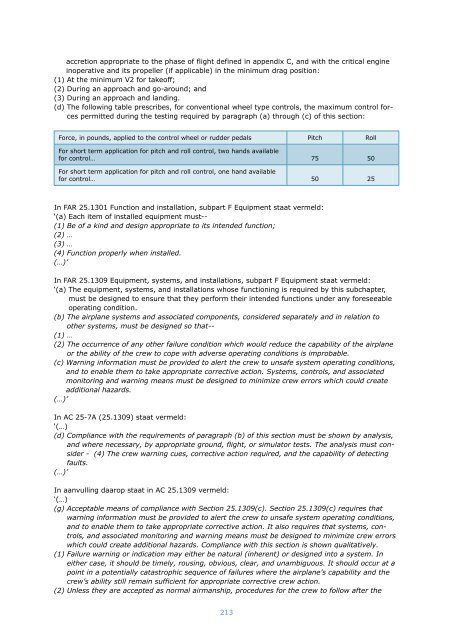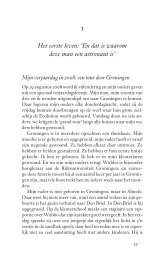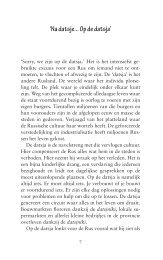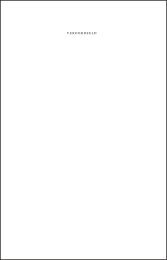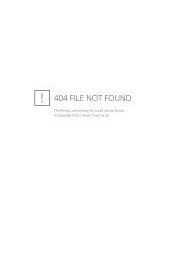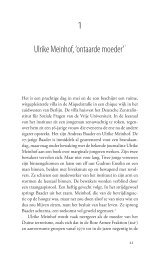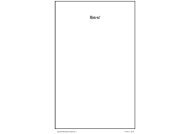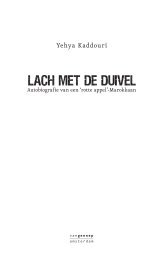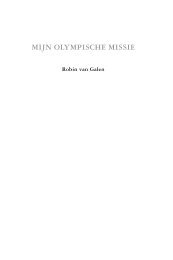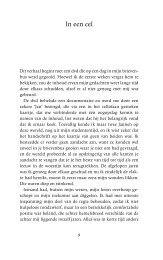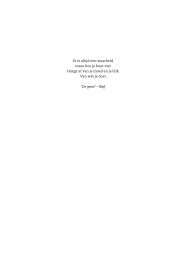rapporten - Pauw & Witteman
rapporten - Pauw & Witteman
rapporten - Pauw & Witteman
You also want an ePaper? Increase the reach of your titles
YUMPU automatically turns print PDFs into web optimized ePapers that Google loves.
accretion appropriate to the phase of flight defined in appendix C, and with the critical engine<br />
inoperative and its propeller (if applicable) in the minimum drag position:<br />
(1) At the minimum V2 for takeoff;<br />
(2) During an approach and go-around; and<br />
(3) During an approach and landing.<br />
(d) The following table prescribes, for conventional wheel type controls, the maximum control forces<br />
permitted during the testing required by paragraph (a) through (c) of this section:<br />
Force, in pounds, applied to the control wheel or rudder pedals Pitch Roll<br />
For short term application for pitch and roll control, two hands available<br />
for control… 75 50<br />
For short term application for pitch and roll control, one hand available<br />
for control… 50 25<br />
In FAR 25.1301 Function and installation, subpart F Equipment staat vermeld:<br />
‘(a) Each item of installed equipment must--<br />
(1) Be of a kind and design appropriate to its intended function;<br />
(2) …<br />
(3) …<br />
(4) Function properly when installed.<br />
(…)’<br />
In FAR 25.1309 Equipment, systems, and installations, subpart F Equipment staat vermeld:<br />
‘(a) The equipment, systems, and installations whose functioning is required by this subchapter,<br />
must be designed to ensure that they perform their intended functions under any foreseeable<br />
operating condition.<br />
(b) The airplane systems and associated components, considered separately and in relation to<br />
other systems, must be designed so that--<br />
(1) …<br />
(2) The occurrence of any other failure condition which would reduce the capability of the airplane<br />
or the ability of the crew to cope with adverse operating conditions is improbable.<br />
(c) Warning information must be provided to alert the crew to unsafe system operating conditions,<br />
and to enable them to take appropriate corrective action. Systems, controls, and associated<br />
monitoring and warning means must be designed to minimize crew errors which could create<br />
additional hazards.<br />
(…)’<br />
In AC 25-7A (25.1309) staat vermeld:<br />
‘(…)<br />
(d) Compliance with the requirements of paragraph (b) of this section must be shown by analysis,<br />
and where necessary, by appropriate ground, flight, or simulator tests. The analysis must consider<br />
- (4) The crew warning cues, corrective action required, and the capability of detecting<br />
faults.<br />
(…)’<br />
In aanvulling daarop staat in AC 25.1309 vermeld:<br />
‘(…)<br />
(g) Acceptable means of compliance with Section 25.1309(c). Section 25.1309(c) requires that<br />
warning information must be provided to alert the crew to unsafe system operating conditions,<br />
and to enable them to take appropriate corrective action. It also requires that systems, controls,<br />
and associated monitoring and warning means must be designed to minimize crew errors<br />
which could create additional hazards. Compliance with this section is shown qualitatively.<br />
(1) Failure warning or indication may either be natural (inherent) or designed into a system. In<br />
either case, it should be timely, rousing, obvious, clear, and unambiguous. It should occur at a<br />
point in a potentially catastrophic sequence of failures where the airplane’s capability and the<br />
crew’s ability still remain sufficient for appropriate corrective crew action.<br />
(2) Unless they are accepted as normal airmanship, procedures for the crew to follow after the<br />
213


